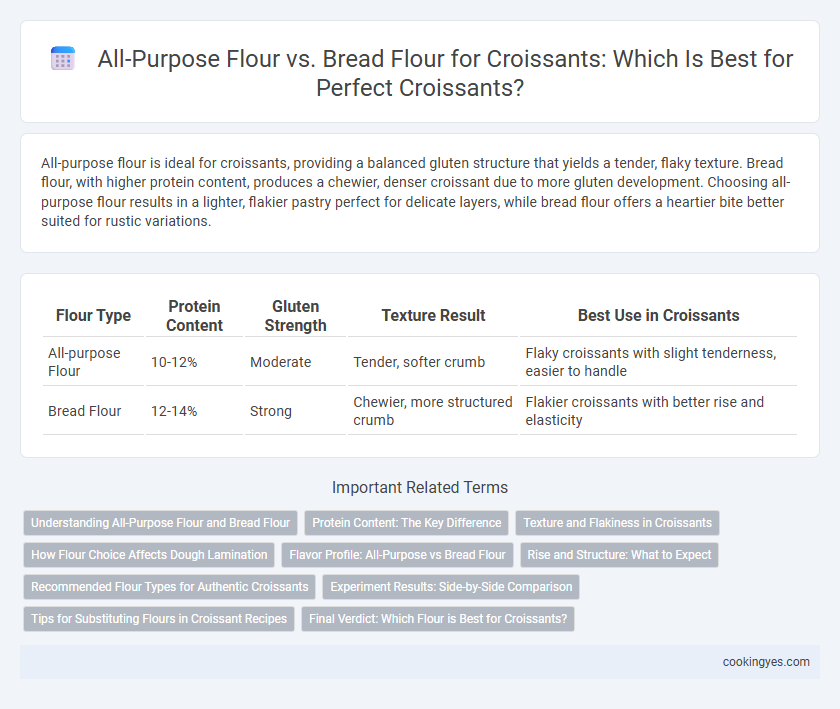All-purpose flour is ideal for croissants, providing a balanced gluten structure that yields a tender, flaky texture. Bread flour, with higher protein content, produces a chewier, denser croissant due to more gluten development. Choosing all-purpose flour results in a lighter, flakier pastry perfect for delicate layers, while bread flour offers a heartier bite better suited for rustic variations.
Table of Comparison
| Flour Type | Protein Content | Gluten Strength | Texture Result | Best Use in Croissants |
|---|---|---|---|---|
| All-purpose Flour | 10-12% | Moderate | Tender, softer crumb | Flaky croissants with slight tenderness, easier to handle |
| Bread Flour | 12-14% | Strong | Chewier, more structured crumb | Flakier croissants with better rise and elasticity |
Understanding All-Purpose Flour and Bread Flour
All-purpose flour contains moderate protein levels, typically around 10-12%, which provides a balanced gluten development ideal for croissants with a tender yet flaky texture. Bread flour has a higher protein content, usually 12-14%, resulting in stronger gluten formation that delivers more chewiness and structure, often leading to a more robust and layered pastry. Choosing between all-purpose and bread flour affects croissant dough elasticity, rise, and final crumb consistency, influencing the delicate balance between softness and flakiness.
Protein Content: The Key Difference
Protein content is the key difference between all-purpose flour and bread flour when making croissants. Bread flour contains about 12-14% protein, which develops stronger gluten, providing the dough with elasticity and structure needed for flaky layers. All-purpose flour, with 10-12% protein, yields a softer, more tender croissant but may lack the same level of rise and crispness as those made with bread flour.
Texture and Flakiness in Croissants
All-purpose flour produces croissants with a tender crumb and moderate flakiness due to its balanced protein content of 10-12%, which provides enough gluten development for softness without excessive chewiness. Bread flour, containing higher protein levels around 12-14%, results in croissants with a chewier texture and enhanced layered flakiness, as stronger gluten networks better trap steam during baking. Choosing between all-purpose and bread flour directly impacts the croissant's texture, with all-purpose offering delicate softness and bread flour delivering pronounced layers and crispness.
How Flour Choice Affects Dough Lamination
All-purpose flour typically contains 10-12% protein, offering moderate gluten strength that allows for easier dough handling and a tender, flaky croissant crumb. Bread flour, with 12-14% protein, develops stronger gluten networks crucial for maintaining distinct layers during lamination, resulting in a chewier texture and more pronounced rise. Choosing between all-purpose and bread flour directly influences dough elasticity and extensibility, affecting the evenness of butter distribution and the final flakiness of the croissant.
Flavor Profile: All-Purpose vs Bread Flour
All-purpose flour produces croissants with a tender crumb and a slightly softer texture, enhancing buttery flavors and subtle sweetness. Bread flour, due to its higher protein content, yields a chewier, crispier crust and a more pronounced, nutty flavor from Maillard reactions during baking. The choice between all-purpose and bread flour impacts not only texture but also the depth and intensity of the croissant's flavor profile.
Rise and Structure: What to Expect
All-purpose flour provides a moderate protein content of around 10-12%, resulting in a softer croissant with a tender crumb but less rise and structure compared to bread flour. Bread flour, with its higher protein content of 12-14%, develops more gluten, yielding a stronger dough that traps more gas during fermentation, leading to a higher rise and flakier, more structured layers. For croissants, bread flour enhances the dough's elasticity and oven spring, creating the characteristic crisp and airy texture essential for traditional French pastries.
Recommended Flour Types for Authentic Croissants
Authentic croissants benefit from using bread flour due to its higher protein content, typically around 12-14%, which provides the necessary gluten strength for the dough's layering and rise. All-purpose flour has a lower protein content, usually 9-11%, resulting in a softer texture but less structural integrity in the flaky layers. Bakers aiming for traditional, flaky, and airy croissants often recommend bread flour to achieve optimal elasticity and crispiness.
Experiment Results: Side-by-Side Comparison
Experiment results reveal that croissants made with bread flour yield a chewier texture and more pronounced layers due to higher gluten content, while all-purpose flour produces a tender crumb with slightly less structure. Side-by-side comparison shows bread flour croissants have greater rise and flakiness, whereas all-purpose flour croissants offer a softer bite and more delicate crust. Baker preferences depend on desired balance between elasticity and tenderness in the final pastry.
Tips for Substituting Flours in Croissant Recipes
When substituting all-purpose flour for bread flour in croissant recipes, expect a slightly tender crumb due to lower gluten content, which may reduce dough elasticity and rise. To compensate, increase kneading time to develop gluten strength or add vital wheat gluten at a ratio of 1 tablespoon per cup of all-purpose flour to mimic bread flour's properties. Maintaining proper dough hydration and allowing ample proofing time ensures flakier layers and optimal texture despite flour substitution.
Final Verdict: Which Flour is Best for Croissants?
Bread flour is ideal for croissants due to its higher protein content, which develops more gluten, resulting in a chewier texture and better rise. All-purpose flour creates a softer, less structured crumb but may yield less lift and flakiness. For buttery, flaky croissants with optimal volume and texture, bread flour is the preferred choice.
All-purpose flour vs Bread flour for Croissant Infographic

 cookingyes.com
cookingyes.com